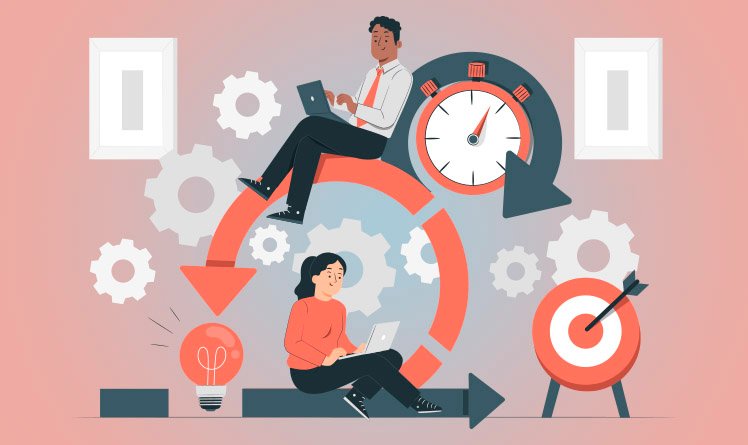Eisenhower Matrix: What It Is and How to Do It

|
Getting your Trinity Audio player ready...
|
In our fast-paced world, we're constantly bombarded with tasks and responsibilities vying for our attention. As a result, we often find ourselves trapped in a cycle of urgency that prevents us from focusing on what truly matters. But how can we better organize our time and effectively prioritize? The answer may lie in the Eisenhower Matrix, a simple and powerful method for optimizing productivity and reducing stress. Check it out!
What is the Eisenhower Matrix?
The Eisenhower Matrix has its roots in the experience of former U.S. President Dwight D. Eisenhower, who faced constant challenges in making strategic decisions and managing multiple responsibilities. As a U.S. Army general and later as president, he realized that not all tasks required his immediate attention, but some were critical to long-term success.
Thus, this principle led to the creation of the method we now know as the Eisenhower Matrix, an approach widely adopted by managers, entrepreneurs and professionals to optimize the use of time and maximize productivity.
The importance of time management
Managing time effectively is a constant challenge, especially in a world filled with distractions and tight deadlines. Furthermore, the way we manage our time directly impacts our productivity, mental health, and well-being. Without an effective method, we risk spending our days putting out "fires" instead of focusing on what truly matters.
The Eisenhower Matrix is a simple yet effective solution to help with this process, as it helps categorize activities based on their urgency and importance, allowing for better time allocation.
How the Eisenhower Matrix Works
To better visualize the Eisenhower Matrix, see the illustration below:

This matrix helps categorize activities and make more strategic decisions about how to act on each of them.
The four quadrants of the matrix
The Eisenhower Matrix divides tasks into four quadrants:
- Important and Urgent: Tasks that require immediate action, such as crises, critical deadlines, and emergencies.
- Important, but Not Urgent: Activities that have a long-term impact, such as strategic planning, personal development and physical exercise.
- Urgent, but Not Important: Tasks that can be delegated, such as some emails, irrelevant meetings, and constant interruptions.
- Neither Urgent, Nor Important: Distractions that can be eliminated, such as excessive social media and activities with no productive value.
Difference between urgency and importance
Not everything that's urgent is important. Often, urgent tasks arise as demands from third parties and may not contribute to our goals. Therefore, distinguishing between these concepts is essential to maintain focus and avoid overload.
Stephen Covey's Influence on the Eisenhower Matrix
Author Stephen Covey helped popularize the Eisenhower Matrix by introducing it in his book The 7 Habits of Highly Effective People. In this sense, he highlighted the importance of quadrant 2 (Important, but Not Urgent), arguing that this is where true personal and professional growth occurs. Thus, Covey emphasized that many people get lost solving only urgent problems, without investing time in strategic activities that would bring long-term benefits.
How to apply the Eisenhower Matrix in everyday life
Step 1: Listing tasks
Before applying the matrix, list all the tasks you need to accomplish. Include both professional and personal commitments. It's important to be detailed in this list so as not to neglect activities that, despite seeming secondary, impact your long-term performance.
Step 2: Sorting activities into quadrants
Now, assign each task to one of the four quadrants of the matrix, analyzing whether it's important, urgent, or both. To facilitate this process, ask yourself: Does this task directly contribute to my long-term goals? Does it need to be done now, or can it be scheduled for later? If it's something someone else can do without harm, is it possible to delegate it?
Step 3: Acting according to each quadrant
- Quadrant 1 (Important and Urgent): Resolve them immediately. These are the tasks that can't wait and usually require your full attention.
- Quadrant 2 (Important, but Not Urgent): Plan and prioritize. This is where strategic projects and personal growth are developed, so set realistic deadlines to avoid indefinite postponement.
- Quadrant 3 (Urgent, but Not Important): Delegate to someone else. Be judicious when assigning tasks to third parties, ensuring efficient execution.
- Quadrant 4 (Neither Urgent nor Important): Eliminate or minimize them. These tasks can be major productivity killers, so monitor how much time you spend on them and try to replace them with more constructive activities.
Practical example of application
Beyond the professional example, let's look at how the Eisenhower Matrix can be applied to your personal life. Imagine you're planning a productive and balanced weekend. You need to pay bills, shop for groceries, organize your home, start reading a book, and spend time with your family.
- Pay bills enter the Quadrant 1, as it has an imminent deadline and cannot be postponed.
- Grocery shopping may be in the Quadrant 2, if planned in advance, preventing it from becoming an emergency.
- Organize the house can be delegated or distributed among family members, falling under the Quadrant 3.
- Start reading a book belongs to Quadrant 2, as it contributes to your personal growth.
- Spending excessive time on cell phones or TV generally fits the Quadrant 4, and can be reduced to prioritize more relevant activities.
In this way, the matrix helps to structure a productive weekend, balancing obligations and leisure without overload.
Imagine you have an important report due in three days, need to respond to dozens of emails, want to start an online course, and spend too much time checking social media. Applying the matrix:
- THE report goes into Quadrant 1, as it is important and has a deadline.
- THE online course goes to Quadrant 2, as it impacts your professional growth, but does not require immediate action.
- To respond all emails can be a Quadrant 3 trap. Some are really relevant, but others can be delegated or responded to more efficiently.
- THE time on social media falls into Quadrant 4. If it's not adding value, it's best to reduce that habit.
Benefits of the Eisenhower Matrix for Productivity and Well-Being
Greater control over time
One of the greatest advantages of the Eisenhower Matrix is the sense of control it provides. This way, instead of passively reacting to external demands and unexpected events, you take control of your schedule, ensuring that time is invested in the right tasks.
Reducing stress and overload
Knowing what really matters prevents that feeling of always racing against time. Furthermore, by minimizing the urgency of important tasks, we reduce the pressure and anxiety of everyday life.
Increased efficiency and productivity
The Eisenhower Matrix allows us to focus our efforts on the tasks that truly make a difference. This way, we avoid procrastinating on important tasks and eliminate distractions. we can be more productive and we can achieve our goals in a more structured way.
Better work-life balance
Many people find themselves overwhelmed with urgent tasks, neglecting important aspects of their personal lives. In this sense, applying the matrix allows for a more balanced distribution of time, ensuring that family commitments, health, and leisure are also prioritized.
Development of a strategic mindset
By using the Eisenhower Matrix regularly, we develop a habit of thinking strategically about our time. This way, we can anticipate problems before they become urgent and learn to focus on what truly generates long-term value.
Greater clarity in decision-making
With a clear prioritization system, we avoid indecision and gain confidence to make more assertive decisions. Knowing where to focus our energy gives us a more objective view of daily tasks.
In short…
The Eisenhower Matrix is an incredibly simple yet effective tool for managing tasks and prioritizing what truly matters. Applying it daily not only increases productivity but also improves quality of life, helping to reduce stress and promote a better work-life balance. Why not start right now? Grab a piece of paper, make your list, and start organizing your time more intelligently!
Reading Suggestion

The 7 Habits of Highly Effective People – Stephen R. Covey
Image: Freepik

Marcel Castilho is an expert in neuromarketing, neuroscience, mindfulness and positive psychology. In addition to being an advertiser, he also has a Master's degree in NLP – Neurolinguistic Programming. As the owner and founder of the communications agency VeroCom and also of the digital agency Vero Contents, he has been studying human behavior for over 30 years.

